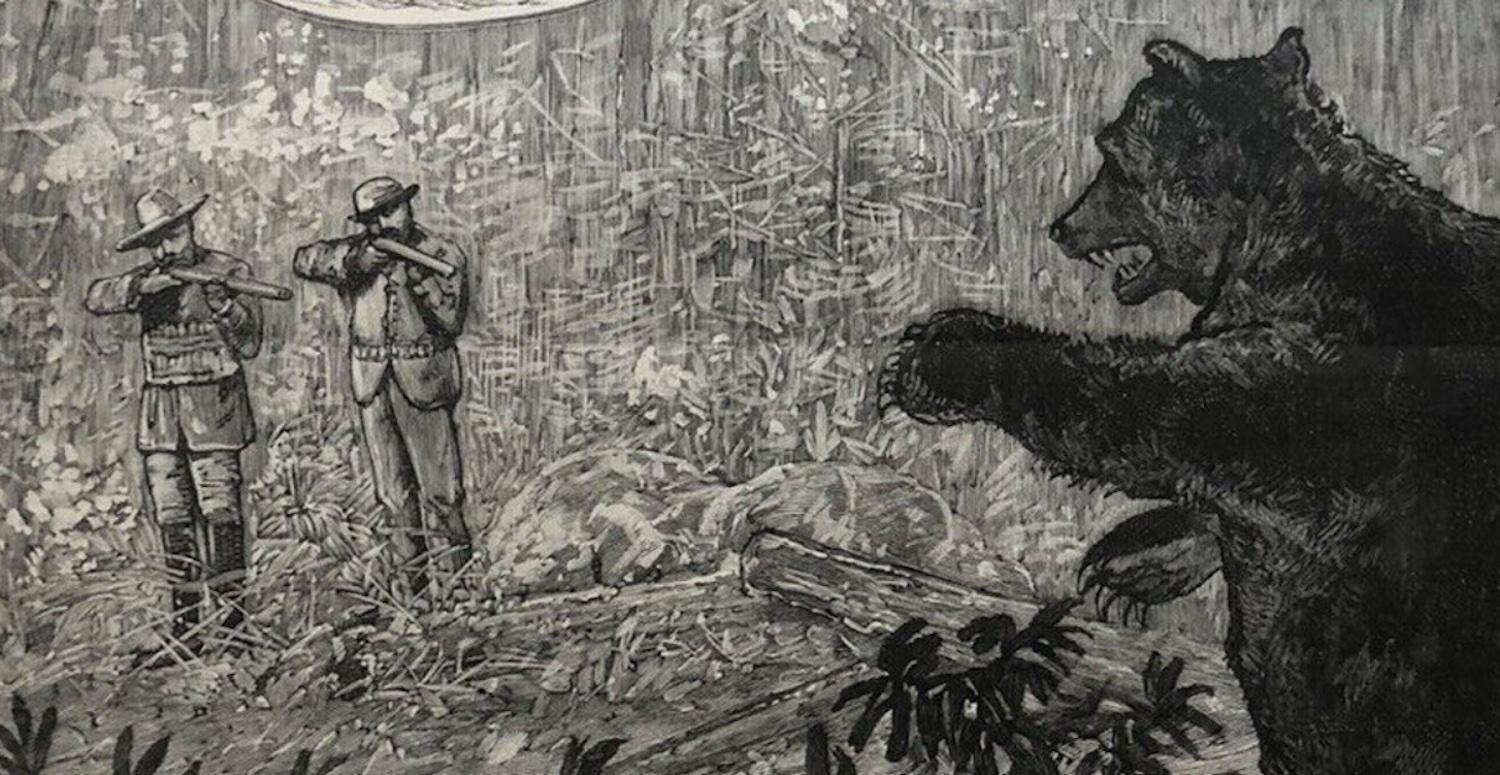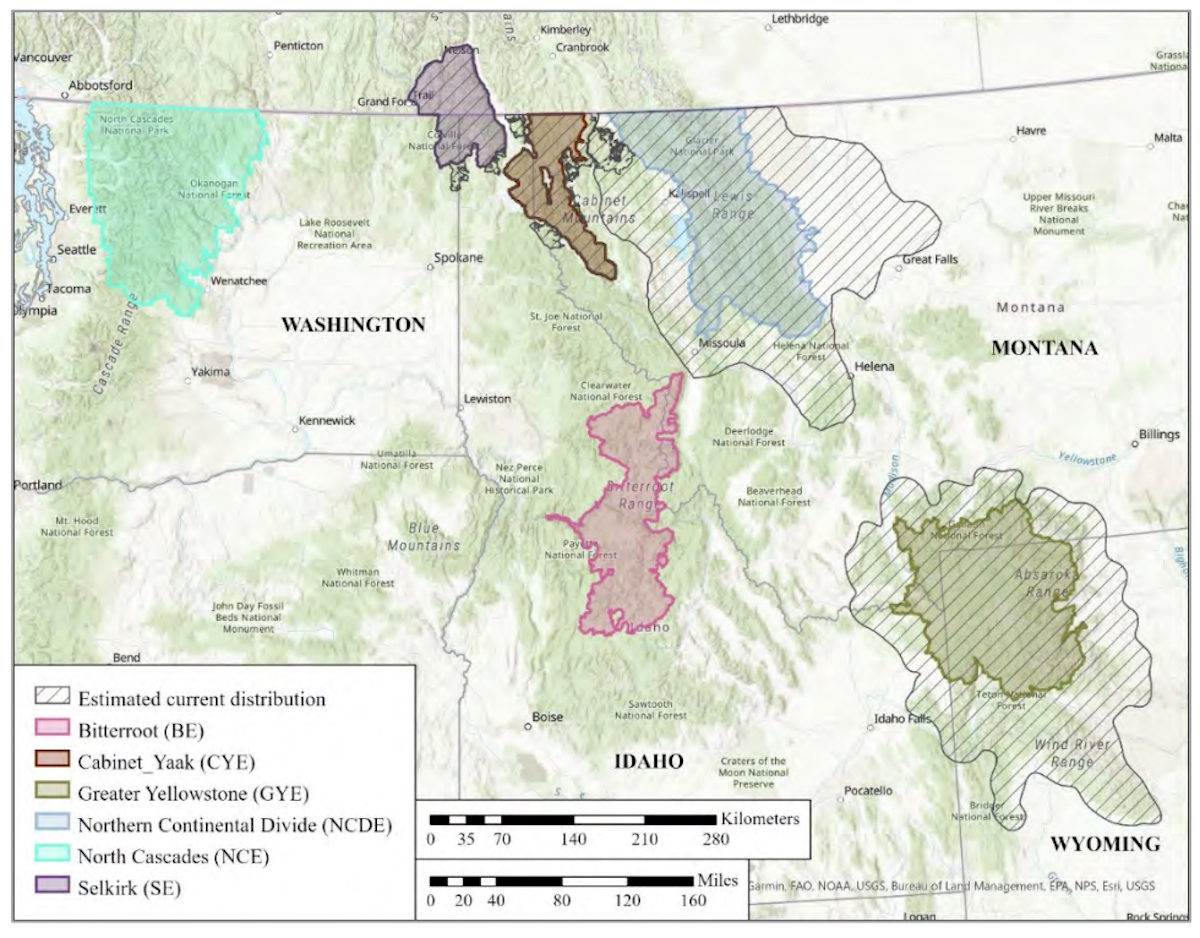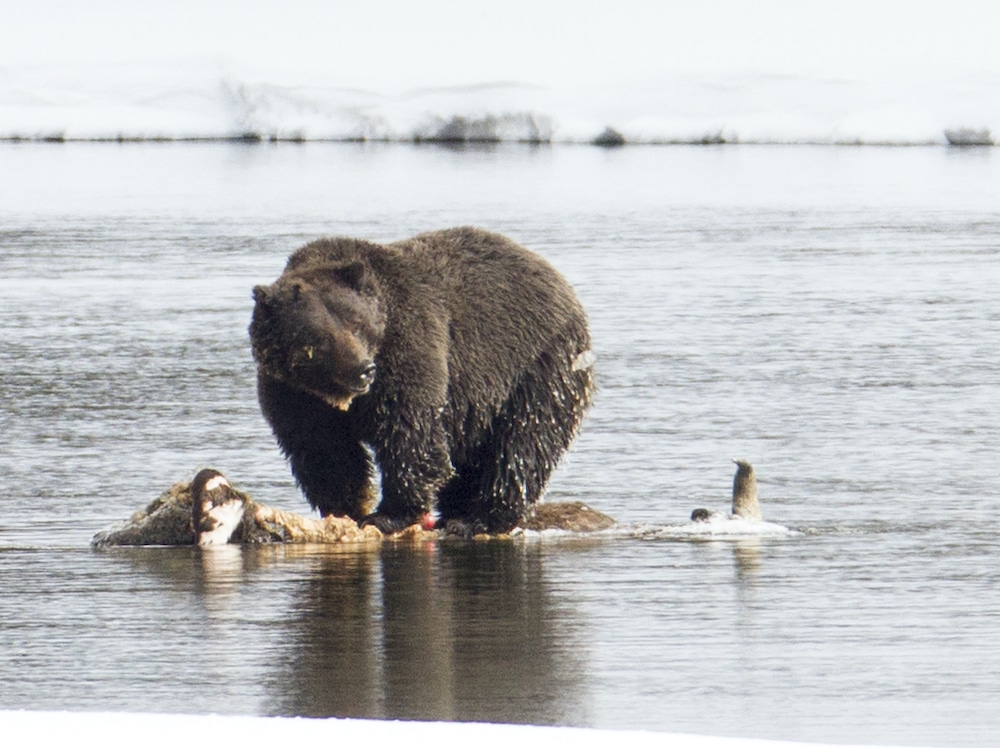
Hunting grizzly bears in Wyoming/Frank Leslie’s Illustrated Newspaper 1844
Wyoming Approves Tri-State Grizzly Hunting Pact In Delisting Push
By Angus M. Thuermer, Jr., Wyofile.com
Wyoming, Idaho and Montana have forged a pact aimed at moving Yellowstone Ecosystem grizzly bears off the federal threatened species list and allowing hunting — by addressing flaws a court found in an earlier delisting effort.
The 13-page memorandum of agreement among the states addresses two problems the U.S. Court of Appeals for the Ninth Circuit found in 2020 when it overturned the U.S. Fish and Wildlife Service’s 2017 removal of federal protections for Greater Yellowstone grizzlies.
The states pledge to manage for a new ecosystem grizzly population goal of 932 bears if federal Endangered Species Act protections are lifted. That upward recalibration responds to a new, more accurate method of estimating bear numbers that finds 1,069 grizzlies — an “on paper” accounting increase over estimates from an earlier, conservative census method.
The tri-state agreement also would ensure genetic diversity of the isolated Yellowstone grizzly community by moving two bears from outside the ecosystem into the area by 2025 if no natural migration occurs by then.
The Wyoming Game and Fish Commission approved the pact Tuesday.
“The recent population estimate of more than 1,000 bears is based on a new counting methodology and the public should be aware that the grizzly bear population did not explode overnight.” -- ANDREA ZACCARDI
Wyoming will use its new agreement to bolster a petition to the federal wildlife agency that would again seek to delist the Yellowstone grizzly and open the door to hunting. The agreement lays out how the three states would distribute potential “discretionary mortalities,” when bears exceed the population goal, including the shooting of grizzlies for sport.
An appeals court in 2020 overturned a 2017 federal decision to delist Yellowstone grizzlies citing two principal reasons. State wildlife managers that were largely in charge of grizzlies at that time had not resolved how they would use more accurate counting methods. At issue was whether states would recalibrate population goals in tandem with new population estimates.
In addition to the recalibration issue, states had not adequately settled worries about the isolated population’s long-term genetic diversity and viability.
“Wyoming intends to directly address those issues,” Rick King, chief of the Wyoming Game and Fish Department’s wildlife division, told a teleconference meeting of the agency’s governing commission last Tuesday. The updated 2021 tri-state agreement would do that, he said.
Conservation or outrageous request?
Wyoming Gov. Mark Gordon, who said last fall he would petition the USFWS to again declare the Yellowstone Ecosystem grizzly recovered, lauded the agreement.
“This [Game and Fish memorandum] approval reaffirms Wyoming’s vow and commitment to long-term grizzly bear conservation and underscores the fact that wildlife management is best placed in the hands of states, not the federal government,” he said in a statement Tuesday. Neither Montana nor Idaho had approved their memoranda by then, his statement read, although the states forged the pact together.
Gordon’s delisting petition would seek to again reclassify the Yellowstone Ecosystem population as a segment “distinct” from grizzlies in the other five U.S. grizzly bear recovery zones. In the Yellowstone Ecosystem population, extinction is no longer a threat, the petition will assert.

The six U.S. grizzly bear recovery zones and occupied habitat./U.S. Fish and Wildlife Service
An attorney at the Center for Biological Diversity, a group that supports grizzly protection, was skeptical about the revised counting method and delisting proposal. “The recent population estimate of more than 1,000 bears is based on a new counting methodology and the public should be aware that the grizzly bear population did not explode overnight,” Andrea Zaccardi said in an email. She urged federal officials to reject Wyoming’s pending “outrageous request.”
Delisting “aims to turn Wyoming’s imperiled grizzly bears into trophy hunting targets,” she said.
The new agreement would increase the population goal for the demographic monitoring area — a 19,270 square-mile zone centered on Yellowstone National Park — where grizzlies count toward Endangered Species Act compliance. Grizzlies outside the DMA would not be subject to the agreement, leaving their fates up to the states upon delisting.
If federal Endangered Species Act protections are removed, the states would strive to maintain 932 grizzlies in the DMA, the 13-page memorandum of understanding states. That new goal would be an increase of 38 percent from today’s target of 674 set by the U.S. Fish and Wildlife Service.
The new goal intends to resolve the recalibration issue singled out by the appeals court in 2020. The 38 percent boost, however, appears to fall shy of the “on-paper” increase in the ecosystem population between 2020 and today, according to calculations made by WyoFile.
The new counting method engineered by federal scientists put the population at about 1,069 bears, a scientist told officials earlier this month. That’s up from 727 estimated in a 2020 report, an increase of 47 percent.
The new tri-state memorandum also would set a minimum population of 831, up from 600, an increase of about 28 percent. Below that minimum, so-called “discretionary mortality” — conflict-bear removal, hunting and other causes of death that wildlife agencies control — would largely cease.
The states also commit to genetic diversity. “By 2025, the [states] will translocate at least two grizzly bears from outside the [Greater Yellowstone Ecosystem] into the GYE, unless migration from outside the GYE is detected in the interim,” the agreement states.
Sliding scale
The amount of “discretionary mortality” would increase with a larger population and shrink with a smaller one, according to the memorandum. If there were more than 1,033 grizzlies, for example, the total mortality rate for independent males would be 22 percent.
With fewer than 932 grizzlies, the total mortality rate for independent males would fall to below 15 percent. There would be no hunting if the overall population in the DMA declined below 831.

A grizzly bear on a carcass in the Yellowstone River in Yellowstone National Park in March 2016./NPS, Jim Peaco
Similar sliding scales would apply to independent female grizzlies and dependent young. The memorandum assigns 58 percent of allowable discretionary mortalities inside the demographic monitoring area to Wyoming, 34 percent to Montana and 8 percent to Idaho.
The agreement assigns no discretionary mortalities to either Grand Teton or Yellowstone National Parks, places where grizzly conflicts have occurred. Critics have highlighted that omission in a similar, now defunct, 2017 tri-state MOA as a flaw.
Game and Fish characterized the new agreement as one that “recognizes the expanding number of grizzly bears that have grown beyond the edges of the bear’s biological and socially suitable range.” The population has grown “far beyond all scientific requirements for a recovered, viable population,” the agency said in a news release.
Federal protection of Yellowstone ecosystem grizzly bears has vexed Wyoming for years. Federal scientists estimated the population to be 727 bears — using the older counting method — in a 2020 status report. That exceeds the ESA minimum population of 500, the buffer management minimum of 600 and the population goal of 674 – all figures derived from the older counting method.
After the federal government removed its protection of Yellowstone Ecosystem grizzlies in 2017, Wyoming approved a hunt that could have seen more than 20 bears killed. Hunting is generally not allowed in national parks and no plan envisioned bears being killed in Yellowstone or Grand Teton National Parks.
A lawsuit stopped the hunt, overturned the federal delisting for Yellowstone bears and led to today’s positions. The Fish and Wildlife Service has no delisting plans, it said earlier this year after reviewing the grizzly’s status outside Alaska.
“We recommended no change to the threatened status of the grizzly bear in the lower-48 States,” the agency said in its 2020 annual report.
The new counting method changes the way female grizzlies with cubs are tallied by altering what’s known as a distance criterion. The old, conservative method did not tally more than one female with offspring in an area 30 kilometers in radius.
Scientists are now confident they don’t need that precautionary 30-kilometer “distance criterion” and can reduce it to 16.
The increased population estimate is due to that change in methodology. There are, essentially, just as many bears in the ecosystem today as there were under the earlier population-estimating formula.


 Support Essential Coverage of Essential Places
Support Essential Coverage of Essential Places
Comments
Before any grizzly hunting is approved why is Idaho not working with the Forest Service for recovery of bears to the Selway/Frank Church Wilderness???
This is good news. This will get the states in a position to manage the Bears they are the ones that can do it most effectively. Also the money received from selling a hunting license will be used to support the bear population through other means